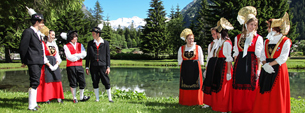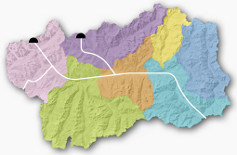Myths and legends in the Aosta Valley
The protagonists of the fantastic traditions of the Aosta Valley
Myths and legends are tales from popular traditions where the protagonists approach creatures of incredible dimensions — gods, heroes, witches, ghosts, demons or saints. At times, the tales talk about fantastic origins or environmental morphology or historic events transformed by fantasy; the truth in these tales are open to interpretation, faced with a world of magic and fairy tale, however this veil of spirituality supports the ritual phases in which myths and legends form the foundations of popular festivals, with the important function of strengthening the origins of communities.
There are different collections, even of literary value, of Valdostane myths and legends and it would be difficult to consider all the tales, often with multiple forms. Certain are based on the fantastic birth and transformation of the mountains, lakes, plants and flowers; others talk of “diabolic” actions – with the frequent appearance of the devil in local tradition.
Some stories cover religious themes. Saints are celebrated for their intercession with God, leading to small miracles. The most frequent of the many saints's names include St. Martin, St. Orso, St. Anselm and St. Bernard (the last two are still significant in today's culture).
Witches are also often present in tales; their stories lapse between fantasy and reality, in a region in which past historians have long since denied the presence of the Inquisition. Only in recent years has investigations into the issue been attributed to members of the Order of Friars Minor or the tax prosecutor (ecclesiastical figure). It is worth noting that women investigated for witchcraft were often guaranteed the right to a defence, through a legal expert: a form of guarantee not always applied in parallel contexts.
Ghosts appear in tales and in more modern forms of popular word of mouth: “dark” magazines,blogs and websites. Here are a few quotes (with a hint of fantasy and the benefit of invention): tales of the ”presence” of an armiger from 17th century in Saint Marcel Castle; of a woman who died for a crime she didn't commit, in the 16th century, in Quart Castle; and the spirit of Countess Bianca Maria of Challant in Issogne Castle, her residence from 1522 to 1525. Bianca Maria was just twenty when she was sent to trial and condemned to decapitation for a crime she didn't commit. It is said that a ghost appears in summer, near the octagonal fountain in the castle courtyard.













